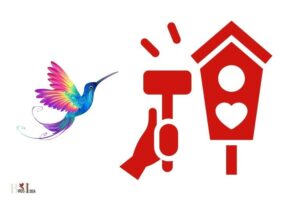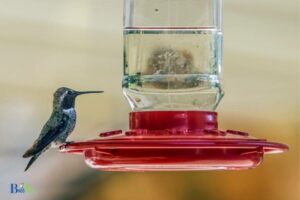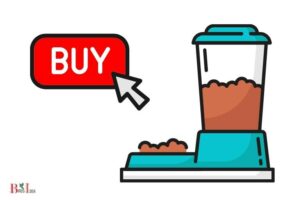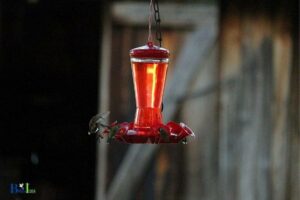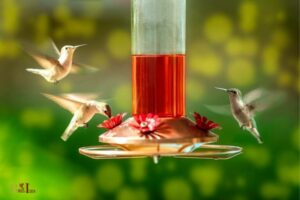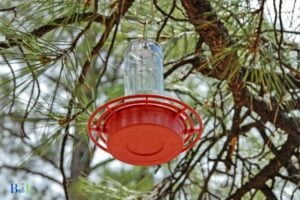How To Get Mold Out Of Hummingbird Feeder? Steps!
To effectively get mold out of a hummingbird feeder, you need to disassemble the feeder, soak it in a mixture of bleach and water, scrub it using a small brush, rinse thoroughly, and ensure it is completely dry before refilling.
To get rid of mold from a hummingbird feeder, a cleaning solution of vinegar and water is effective and safe for the birds.
By regularly cleaning your hummingbird feeder with a vinegar and water solution, you can ensure it remains mold-free.
This not only keeps the feeder looking fresh but is also essential in maintaining the health and safety of your hummingbird visitors.
10 Steps to Get Mold Out Of Hummingbird Feeder
| Step | Description |
|---|---|
| 1 | Inspect the feeder for visible mold |
| 2 | Disassemble the feeder parts |
| 3 | Prepare a cleaning solution (1 part bleach to 9 parts water) |
| 4 | Soak the feeder parts in the cleaning solution for 1 hour |
| 5 | Use a brush or sponge to scrub away any remaining mold |
| 6 | Rinse thoroughly with clean water |
| 7 | Allow the feeder parts to air dry completely |
| 8 | Reassemble the feeder |
| 9 | Refill with fresh nectar and hang the feeder back up |
Key Takeaway

Five Facts About: Mold Out Of Hummingbird Feeder
Simple Tips to Get Mold Out of the Hummingbird Feeder
To get mold out of a hummingbird feeder, you must clean and sanitize the feeder thoroughly. Mold is harmful not just to your hummingbirds but also to other birds that visit the feeder.
It’s essential to remove mold as soon as you notice it and follow a regular cleaning routine to keep the feeder safe and clean for the birds.
Here are some simple tips to get mold out of your hummingbird feeder:
- Disassemble the feeder: Take apart the feeder to clean each part properly.
- Use warm soapy water: Fill a basin or sink with warm water and dish soap, then let the feeder parts soak for a while.
- Scrub gently: Use a soft brush or cloth to clean the feeder parts, paying special attention to areas with mold.
- Sanitize with vinegar: Mix a solution of 1 part white vinegar to 4 parts water and soak the feeder parts in this solution for at least 10 minutes.
- Rinse thoroughly: Rinse all parts of the feeder under running water to remove any soap or vinegar residue.
- Dry completely: Allow the feeder to air-dry fully before reassembling and refilling with nectar.
Following these steps will help you remove mold from your hummingbird feeder and keep your feathered friends healthy and happy.
“Mold is not only unsightly, it can pose serious health risks to hummingbirds. It’s important to regularly clean and maintain your feeder to ensure it’s a safe and welcoming place for these tiny birds.”
– Birding Expert, John James Audubon
Essential Cleaning Supplies for Removing Mold from a Hummingbird Feeder
Mold can be harmful to hummingbirds and can deter them from using your feeder.
To clean your feeder thoroughly and get rid of any mold, it’s essential to have the right cleaning supplies on hand.
These supplies ensure that you not only remove the existing mold but also prevent future mold growth, making the feeder a safe and hygienic place for the birds.
Pro Tip: Remember to clean your hummingbird feeder every three to five days, depending on the outdoor temperature and how quickly the nectar is consumed. Regular cleaning and maintenance will prevent mold growth and ensure a safe environment for your hummingbirds.
birdsidea
DIY Cleaning Solution for Getting Mold Out of a Hummingbird Feeder
Mold inside a hummingbird feeder is not only unsightly but also potentially harmful to the birds.
To ensure the health of the hummingbirds and keep the feeder clean, you can create a simple DIY cleaning solution that effectively removes mold and keeps it from coming back.
The key to this solution is using natural, non-toxic ingredients that won’t harm the hummingbirds while also keeping the feeder mold-free.
Prevention Tricks to Stop Mold Growing on a Hummingbird Feeder
Mold growth in a hummingbird feeder can be harmful to the birds and make the feeder unattractive.
To prevent mold from growing in your hummingbird feeder, proper maintenance and following specific cleaning practices are essential.
Regular cleaning, using the right solutions, and keeping the feeder in optimal conditions can significantly reduce mold formation.
- Regular cleaning
- Replace nectar every 2-3 days
- Use appropriate cleaning solutions
- Proper feeder storage
- Inspect for cracks and damage
According to a study by the National Wildlife Federation, keeping bird feeders clean can reduce the risk of bird-borne diseases by up to 80%.
birdsidea
What kills mold in a Hummingbird Feeder?
Here are some additional tips to keep your hummingbird feeder mold-free:
- Clean your feeder regularly, ideally every 3-4 days in warm weather to prevent mold and bacteria buildup.
- Use hot water and a bottle brush to thoroughly clean all parts of the feeder, including the feeding ports and perches.
- Only fill the feeder with enough nectar that the birds will consume within 2-3 days to prevent the nectar from going bad and attracting mold.
- Place the feeder in a shady spot to keep it out of direct sunlight and prevent the nectar from spoiling.
- Consider using a hummingbird feeder with removable parts that are dishwasher safe for easy and thorough cleaning.
Remember, hummingbirds are attracted to fresh, clean nectar, so by keeping your feeder free of mold, you’ll not only keep the birds healthy but also encourage more of them to visit your backyard.
Tip: Hummingbirds are the only birds that can fly backward.
birdsidea
How to Prevent Mold Growth in Hummingbird Feeders?
Mold is not only unsightly but can also be harmful to hummingbirds. The fungus can cause respiratory infections and even death if not addressed immediately.
As a responsible hummingbird enthusiast, it’s essential to ensure that your nectar feeders are always clean and free of mold.
Proper maintenance of the feeder is crucial to prevent mold growth and keep the hummingbirds healthy and happy.
Here are some tips on how to prevent mold growth in hummingbird feeders:
- Clean the feeder thoroughly every four to five days.
- Use hot, soapy water and a bottle brush to scrub all parts of the feeder, including the ports and the feeding bottle.
- Rinse thoroughly with hot water and allow it to dry completely before refilling with nectar.
- Avoid using dish soap or bleach, as they can leave harmful residues that may harm the birds.
- Store the feeder in a dry and well-ventilated area, away from direct sunlight, when not in use.
By following these simple steps, you can prevent mold growth and keep your hummingbirds healthy and happy.
Remember to be consistent in cleaning your feeder, and keep an eye out for any signs of mold growth.
- Moldy nectar can cause infection and even death to hummingbirds.
- The proper maintenance of the feeder is crucial in preventing mold growth.
- Clean the feeder using hot, soapy water every 4 to 5 days.
- Rinse thoroughly with hot water and dry it completely before refilling.
- Avoid using bleach or dish soap to clean the feeder.
- Store the feeder in a dry and well-ventilated area away from direct sunlight when not in use.
Hummingbirds can fly at a speed of up to 60 miles per hour.
Can vinegar be used to clean hummingbird feeders?
Hummingbirds are delicate creatures that need a clean and sanitized environment to thrive. Therefore, keeping their feeders free from mold, bacteria, and other impurities is essential.
One of the most common methods of cleaning hummingbird feeders is to use vinegar. Vinegar is a natural cleaning agent that can effectively remove dirt and grime without leaving any harmful chemical residue that could harm hummingbirds.
However, some people are concerned that vinegar may be harmful to hummingbirds if it’s not properly rinsed.
Let’s take a closer look at the issue and determine whether vinegar is safe to use for cleaning hummingbird feeders.
- Vinegar is a natural cleaning agent that can help remove mold and other contaminants from hummingbird feeders.
- Some experts recommend using a solution of one part white vinegar to four parts water when cleaning hummingbird feeders.
- Vinegar is a food-grade substance that is generally safe for humans and wildlife when used in small amounts.
- If you use vinegar to clean a hummingbird feeder, make sure to thoroughly rinse the feeder with clean water before refilling it with nectar.
- Using too much vinegar or not rinsing the feeder properly can lead to a strong scent that may deter hummingbirds from feeding.
While vinegar can be an effective and safe cleaning agent for hummingbird feeders, it’s important to use it correctly and rinse it thoroughly to avoid any adverse effects on hummingbirds.
By maintaining a clean and sanitary environment for hummingbirds, you can help support their health and well-being in your own backyard.
Can you use baking soda to clean a hummingbird feeder?
Hummingbird feeders are a great addition to any garden or backyard, but they require regular cleaning to ensure that mold and bacteria don’t build up inside.
One common household item that people often turn to for cleaning is baking soda.
Here’s how to do it:
- Mix a solution of one part baking soda to nine parts water.
- Pour the solution into the feeder and gently swirl it around to make sure it covers all surfaces.
- Let it sit for at least an hour, or overnight if the buildup is particularly stubborn.
- Rinse the feeder thoroughly with hot water and let it dry completely before refilling with fresh nectar.
Baking soda is a natural, non-toxic cleaner that can effectively remove mold and other buildup from hummingbird feeders.
However, if you do notice significant amounts of mold or other buildup, it may be time to replace the feeder altogether.
Using baking soda is just one of many ways to clean your hummingbird feeder.
Here are a few other tips to keep in mind:
- Clean your feeder at least once a week, or more frequently in hot and humid weather.
- Use a bottle brush or other specialized cleaning tool to get into all the nooks and crannies of your feeder.
- Avoid using harsh cleaners or bleach, which can be harmful to hummingbirds.
- If you notice multiple birds congregating around your feeder, consider setting up a second feeder to reduce the chances of overcrowding and disease spreading.
Hummingbirds can flap their wings up to 80 times per second!
How to Clean Hummingbird Feeders with Lemon Juice or Vinegar?
If you are an avid hummingbird watcher, keeping your feeders clean is essential to their health.
Mold and bacteria can grow in the nectar, leading to sickness and even death for the birds. One effective way to clean your feeder is by using lemon juice or vinegar.
Both of these natural ingredients are safe for the birds and effective in removing any buildup. To clean your feeder with lemon juice, simply fill the feeder with a mixture of hot water and lemon juice and let it sit for a few hours.
Then, rinse it thoroughly with warm water. To clean with vinegar, use a mixture of one part white vinegar to four parts hot water.
Fill the feeder and let it sit for an hour, then thoroughly rinse with warm water.
- Always clean your feeder every time you refill it with fresh nectar.
- Use a small brush or toothbrush to clean out the small crevices and hard-to-reach areas.
- Never use soap or detergent when cleaning your feeder as this can leave harmful residue.
- Always rinse your feeder thoroughly with warm water to ensure all cleaning solution is removed.
Keeping your hummingbird feeder clean is essential to their health and well-being. Using lemon juice or vinegar is a natural and effective way to remove any buildup.
Make sure you clean your feeder every time you refill it with fresh nectar and rinse it thoroughly with warm water to keep your feathered friends happy and healthy.
FAQ of How To Get Mold Out Of Hummingbird Feeder
How do I safely get rid of mold in my hummingbird feeder?
Then, add a solution of 1 part bleach and 10 parts of water to the feeder. Allow it to sit for 10-30 minutes before rinsing it out with cool water and allowing it to air dry.
How often should I clean my hummingbird feeder?
Is vinegar a safe method for cleaning a hummingbird feeder?
Is bleach an effective way to get rid of mold in a hummingbird feeder?
Conclusion
Hummingbird feeders can be great additions to any backyard, but when mold starts growing, it’s important to clean it out as soon as possible.
The ideal solution to kill mold in your hummingbird feeder is to use white vinegar mixed with water.
This natural, non-toxic mold killer will not harm the birds but will effectively remove the mold and bacteria from the feeder.
After cleaning your hummingbird feeder with this solution, make sure to rinse it well with hot water and allow it to dry completely before refilling it with fresh nectar.

